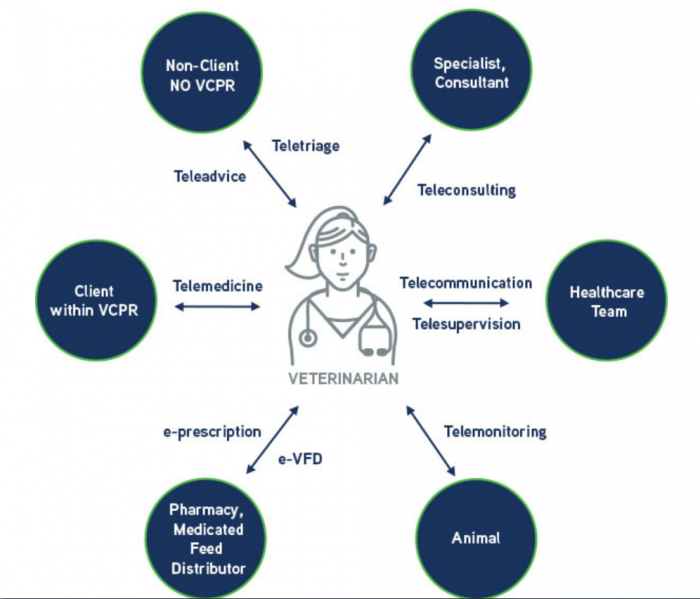Welcome to the confusing world of remote veterinary medicine, or virtual veterinary care. In this series of three blog posts I hope to educate pet owners about this developing field. To be clear, or perhaps that is not the correct thing to say since at this point in time the delivery of remote veterinary care is anything but clear. Here is a pictorial representation of the teleservices industry that the American Veterinary Medical Association uses to provide an overview of this growing sector in the pet health care world.

For this blog entry, I will concentrate on teletriage, the option noted at the 11:00 position in the diagram above. For now, this is the primary service that Trellis Pet Care offers. For most of our clients, in this case veterinary hospitals who need support after-hours, we help pet owners decide if they have an emergency that needs immediate attention. Here is how the AVMA defines this work (AVMA):
“Teletriage is the safe, appropriate, and timely assessment and management (immediate referral to a veterinarian or not) of animal patients via electronic consultation with their owners. In assessing patient condition electronically, the assessor determines urgency and the need for immediate referral to a veterinarian, based on the owner’s (or responsible party’s) report of history and clinical signs, sometimes supplemented by visual (e.g., photographs, video) information. A diagnosis is not rendered. The essence of teletriage is to make good and safe decisions regarding a patient’s disposition (immediate referral to a veterinarian or not), under conditions of uncertainty and urgency.”
One of the key issues in all of veterinary remote or virtual medicine is the presence or absence of a Veterinary Client Patient Relationship, or VCPR. We will dedicate an entire blog post to this term in the future. For now, the easiest way to determine if a VCPR is present is to ask the question, “has the veterinarian on this case actually touched the patient?” If the answer is no, then in most instances, there is no VCPR and the practice of medicine is prohibited. There are many potential variations on this them, but for now, and for most purposes, this general rule applies.
So, when you reach a Trellis Pet Care medical professional on the phone looking for help about potential emergent care, we will work hard to gain as much information we can about the potential medical issues that could be causing your pet’s problem. Technically, since a valid VCPR has not been established, we cannot make a diagnosis. If fact, all we can do is apply a statistical analysis to the historical data and descriptions you provide us to calculate how severe the potential diagnosis might be. In some cases when we have been given permission to do so by the veterinary hospitals that hire us, we may be able to suggest a possible home remedy that you can consider using. This often will take the form of a diagnostic therapeutic trial (yes, we will do a blog post about that subject soon as well) since we cannot prescribe a medication for a specific diagnosis.
In the end, a teletriage event is primarily designed to use shared medical decision making techniques to provide pet owners with the peace of mind they need during a potential emergency situation. Trellis Pet Care stands ready to provide this much-valued peace of mind to pet owners everywhere.
Brad Burrington, D.V.M.
Founder Trellis Pet Care
